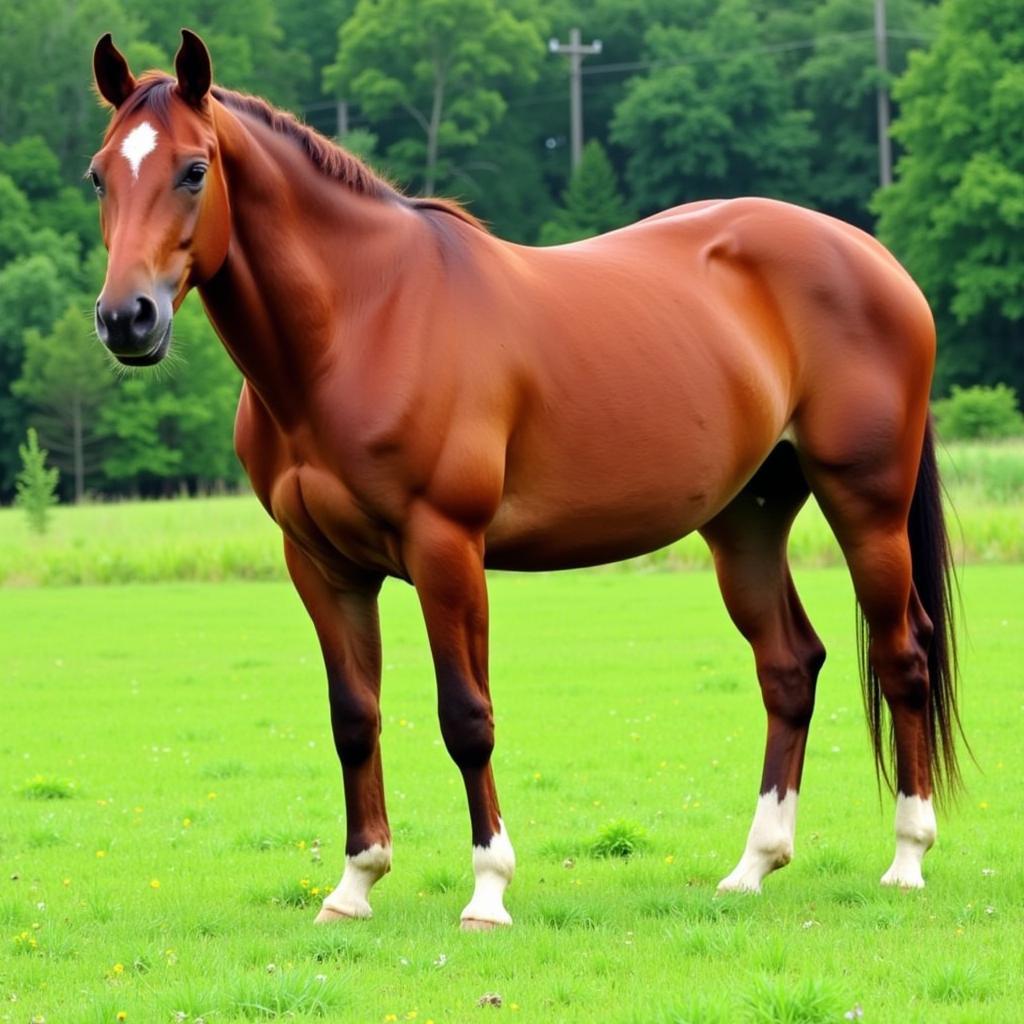The term “Kissed By Fire Horse” often evokes images of a majestic steed with a rich, fiery coat. This phrase generally refers to horses with chestnut coat color variations. But what exactly creates this stunning coloration, and what are the different shades within this captivating color family? Let’s delve into the world of chestnut horses and uncover the secrets behind their vibrant hues.
Decoding the Genetics of the Chestnut Coat
Chestnut, one of the most common horse coat colors, is caused by the presence of a recessive gene. This means that a horse must inherit two copies of the chestnut gene, one from each parent, to express the chestnut coat color. Even a single dominant gene for another color will mask the chestnut gene. This makes identifying hidden chestnut genetics crucial for breeders.
Variations Within the Chestnut Family
While all chestnut horses share the core characteristic of a reddish-brown coat, the shade can vary dramatically. This variation is due to modifier genes that influence pigment intensity and distribution. Let’s explore some of the most common chestnut shades:
- Liver Chestnut: This is the darkest shade, appearing almost black-brown with minimal reddish tones.
- Sorrel: A classic, vibrant reddish-brown, often associated with breeds like Quarter Horses and Paints.
 Sorrel Quarter Horse in a Field
Sorrel Quarter Horse in a Field - Light Chestnut: A lighter, more golden shade of chestnut, often with a flaxen mane and tail.
- Red Chestnut: A particularly intense, almost fiery red color.
Chestnut Horses Through History and Culture
The “kissed by fire” imagery associated with chestnut horses has resonated throughout history and across various cultures. From ancient myths to modern literature, these horses have often been depicted as symbols of power, passion, and even magic.
The Significance of the Mane and Tail
The mane and tail of a chestnut horse can also vary in color, often influenced by the same modifier genes that affect the body coat. Flaxen manes and tails, a lighter, almost blonde color, are a common and striking feature of many chestnut horses.
Caring for Your Chestnut Horse
Caring for a chestnut horse is similar to caring for any other horse coat color. However, the rich red pigment can be prone to sun bleaching, so it’s important to provide adequate shade and consider using coat conditioners to protect the coat’s vibrancy.
“Regular grooming is key for any horse, but with chestnuts, it helps distribute natural oils, maintaining the coat’s shine and preventing it from becoming dull or brittle,” says Dr. Emily Carter, Equine Veterinarian and Coat Color Specialist.
Maintaining a Healthy Coat
A balanced diet and proper hydration are crucial for a healthy coat. Supplements like biotin can also promote healthy hair growth and enhance coat shine.
“Just as with human hair, a horse’s coat reflects its overall health. A dull coat can be a sign of underlying health issues,” adds Dr. Carter.
Conclusion
The “kissed by fire horse,” with its captivating chestnut coat, holds a special place in the equine world. Understanding the genetics and variations within this color family allows us to appreciate the beauty and diversity of these remarkable animals. Proper care and attention will ensure that your chestnut horse continues to shine brightly, showcasing the fiery hues that make them so unique.
FAQ
- Are all chestnut horses the same shade? No, chestnut coat color can range from dark liver chestnut to light, golden shades.
- Is the chestnut gene dominant or recessive? The chestnut gene is recessive.
- Can a chestnut horse have a black mane and tail? It’s very rare, but some chestnut horses can have a sooty mane and tail due to other genetic factors.
- What causes the flaxen mane and tail in chestnut horses? Modifier genes influence the pigment intensity, leading to lighter manes and tails.
- Does coat color affect a horse’s temperament? No, coat color does not influence a horse’s temperament or personality.
- Are chestnut horses more prone to sunburn? Their coat color can make them more susceptible to sun bleaching, so proper care is essential.
- What are some good supplements for maintaining a healthy coat? Biotin is a common supplement that promotes healthy hair growth and coat shine.
For further assistance, please contact us at Phone Number: 0772127271, Email: [email protected], or visit our location at QGM2+WX2, Vị Trung, Vị Thuỷ, Hậu Giang, Việt Nam. We have a 24/7 customer service team available.